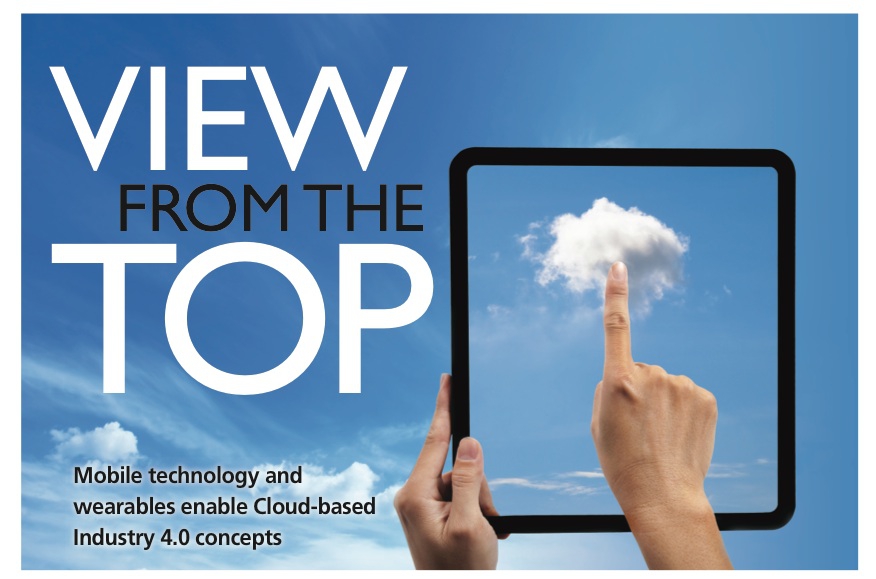
View from the top
June 30, 2015
By Andy Burleigh Beckhoff Automation Canada
Mobile technology and wearables enable Cloud-based Industry 4.0 concepts

Jun. 30, 2015 – In North American industries that are continuously adapting new technologies, Industry 4.0 and Internet of Things (IoT) are two concepts gaining meaningful momentum. While IoT covers a broad range of application areas for highly-connected devices — from the plant floor all the way to the consumer — Industry 4.0, as the name implies, is entirely focused on manufacturing. The philosophy behind it highlights the ideal of the smart factory: a network of cyber-physical operations monitoring physical plant processes and establishing advanced monitoring for better troubleshooting and improved decision-making.
This infinitely-connected manufacturing enterprise is not just a dream of the future, IoT and Industry 4.0 converge today in forward-thinking communication standards, such as OPC UA. In fact, the concepts and goals of Industry 4.0 can be achieved through utilization of the significant advances in secure connection, Cloud-based technologies, and increased usage of mobile devices for dynamic data sharing. The realization of the smart factory is happening now.
Mobile phones and tablets come immediately to mind as a means of enabling dynamic remote access to shared data; the capabilities of these devices increase rapidly as new technologies are released to increase their computing power and functionality. However, the latest technologies in mobile devices can be found with ‘wearables.’ As form factors continue to shrink, devices such as smartwatches and Google Glass provide the foundation for a Cloud-connected revolution, continuously improving access to critical data. Development of these unobtrusive, multi-use devices continues unabated, lowering the barrier of entry for companies looking to implement the principles and processes of the smart factory, as outlined by the ideals of Industry 4.0.
Beckhoff currently has a demo travelling the North American tradeshow circuit, which features a delta robot and a 3-axis machine module, controlled with an embedded PC and TwinCAT software. The system pushes performance data into the Cloud, in this case to an Amazon Cloud server, where it can be accessed via any user device. The remote interface provides users the ability to control the speed and operation of the robot. Demonstrating the openness of the system, users can access the operations by scanning a QR code, and are then directed to a web page containing an interface to control the robot, as well as real-time performance data. Taking access to the next level, this information and control has been made available through a number of wearable devices, most recently a variety of smart watches and Google Glass. Here, users can utilize the Google Glass to access the robot data, as well as controlling the robot operations with both touch and voice activated functions.
The wearables market is highly dynamic from a hardware perspective, and emerging hardware designs will support established connectivity technologies. For example, the Explorer Edition of Google Glass is no longer available, although an updated version will likely be introduced soon, and there are already a number of data glasses concepts from other manufacturers in various stages of development. Provided that these upcoming devices have an open web browser, they can be connected to controls in similar ways. This clearly demonstrates the flexibility of highly-connected access using currently-available, secure communication standards such as OPC UA and PC-based control technology. As an open standard with built-in data security and encryption, OPC UA fosters innovative design and integration by encouraging interoperability in automation. Open specifications enable the standardization of communication, ensuring seamless connection and operation of devices from independent manufacturers around the world. The dream of a true smart factory hinges on the ability of these types of multi-platform, multi-vendor devices to work seamlessly, with little or no effort from the end user, and OPC UA provides a standard to deliver this high level of functionality.
The industrial potential for Cloud-connected wearable technology is limitless, and is usable in any number of vertical markets. Wearable devices have the potential to take great strides in changing the current operating philosophy on machines as a complement to the traditional HMI. Innovations of this magnitude clearly demonstrate how the fusion of IT and automation technology can work within the framework of Industry 4.0 and connected smart factories.
Andy Burleigh is a senior application specialist with Beckhoff Automation Canada.
This article originally appeared in the June 2015 issue of Manufacturing AUTOMATION.